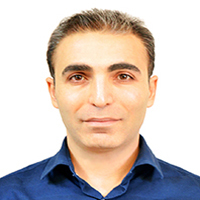Gopat & Shirdal In the Ancient East
Author(s):
Abstract:
This article tries to pursuing the prototypes of "Gopat" and "Shirdal" in the art of ancient Eastern people, to the Achaemenid era (uproar of these cultures combination), by researching their myths and beliefs and also looking at the motifs of their artifacts. With a comparative analysis we hope to find other evidences about cultural relationships between these cultures. Gopat (winged bull/lion with human face) and Shirdal (eagle-head lion) have used in ancient Eastern art since 3rd millennium BC. Man, eagle, lion and bull each have their magical power and territory. When they combine together, the result would be an unconquerable guardian for shrines. These symbols were common signs for dominant royal power in ancient Egypt, Mesopotamia, Iran, Anatolia, Greece and India with different names and descriptions and had a great importance in their mythology and art. The first statues of lion–man were built by Egyptians in mid 3rd millennium BC. These figurines were showing Pharaoh with his human head and beard and body of a bowed lion, that was a symbol of supernatural powers. Maybe Pharaohs did that to demonstrate their intimacy with Sekhmet (mighty lion–head goddess). Mesopotamians added a pair of wings to this mixture. After that Gopat had become a combination of four formidable and important creatureres, with the head of a man, body of a bull, feet of a lion and wings of an eagle. This beast was a sign of two celestial powers: the goddess Lamasu and the god Shedu. In Cristianity these four species turned to four evangelists, who are gathering upon the lord throne. Man for Matthew, lion for Mark, bull for Luke, and eagle for John. Gopat and Shirdal were appearing in Iranian art since late second milleniom BC. We have followed them in the art of Elamite period, Luristan, North and NorthWest region in Iron Age, and finally Achaemenid art. In Iranian mythology Gopat or Gobadshah is a creature who looks after Saryshuk, the supernal bull. We can find a tale about bull–man in "Matikan-e yusht faryan" and an Islamic replication of that, "Marzban nameh". There is another Iranian fictional creature with human head and body of a lion, named "Marti khwar", who is the origion of Manticore in Europian literature. Greecs named this creature griffin. The oldest image of griffin was found in palace of Knossos, Crete (1500 BC). Sphinx in art and mythology of ancient Greece is a monster with female head, body of a lioness, wings of an eagle and a tail with snake head. Sphinx is malevolent and sinister. She couses damage and misery. The most known tale about sphinx is her question of Oedipus. There is also a synthetic creature in Indian mythology named "Purusham Riga" (sanscrit: man–beast). Unlike Gopat in Egypt, Mesopotamia, Iran, Anatoly and Greece, who is just a part of fictions today, Indaians still believe him. They also call him "Narasima" (sanscrit: man–lion). Shirdal in Hinduism and Buddhism has called "Garuda", king of birds and roadster of god Vishnu.
Language:
Persian
Published:
Journal of Fine Arts, Volume:17 Issue: 4, 2013
Page:
13
magiran.com/p1103905
دانلود و مطالعه متن این مقاله با یکی از روشهای زیر امکان پذیر است:
اشتراک شخصی
با عضویت و پرداخت آنلاین حق اشتراک یکساله به مبلغ 1,390,000ريال میتوانید 70 عنوان مطلب دانلود کنید!
اشتراک سازمانی
به کتابخانه دانشگاه یا محل کار خود پیشنهاد کنید تا اشتراک سازمانی این پایگاه را برای دسترسی نامحدود همه کاربران به متن مطالب تهیه نمایند!
توجه!
- حق عضویت دریافتی صرف حمایت از نشریات عضو و نگهداری، تکمیل و توسعه مگیران میشود.
- پرداخت حق اشتراک و دانلود مقالات اجازه بازنشر آن در سایر رسانههای چاپی و دیجیتال را به کاربر نمیدهد.
In order to view content subscription is required
Personal subscription
Subscribe magiran.com for 70 € euros via PayPal and download 70 articles during a year.
Organization subscription
Please contact us to subscribe your university or library for unlimited access!



